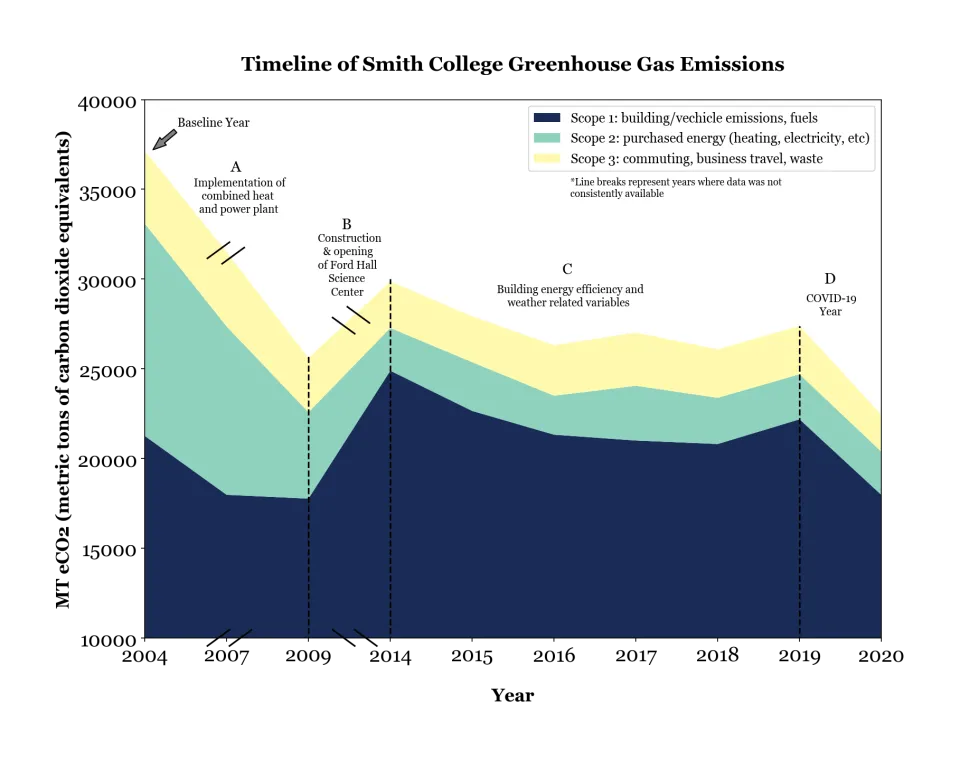GHG Emissions Tracking
The carbon emissions from our campus operations, purchasing decisions, energy sources, and campus-wide individual behaviors impact climate change. In order to slow, stop, and mitigate Smith’s climate change impacts we must track, monitor, and minimize our greenhouse gas emissions.
Upon signing the Second Nature Presidents Climate Commitment in 2007, Smith College began an inventory of greenhouse gas emissions beginning in 1990. This inventory tracks our scope 1 and 2 emissions, and a few components of scope 3 emissions, including waste.
Since 2004, our designated baseline and peak emissions year, we’ve decreased our net emissions by 29% through the installation of our co-generation power plant, converting from #6 fuel oil to fossil fuel gas for heat, energy efficiency measures, and efficient new buildings.

A. Transition to co-generation power plant
Early stages of work to reduce GHGs focused on re-powering our 1947 power plant, powered by fuel oil, to a newer, cleaner, and more efficient co-generation plant. Cogeneration, also called Combined Heat and Power (CHP), is an efficient, clean and reliable approach to generating power and thermal energy from a single fuel source, in our case fossil fuel gas. Smith’s cogeneration system produces electricity for the campus and the byproduct, waste-heat, is used to create steam that in turn heats campus buildings. The cogeneration power plant became fully implemented in 2008. In an average year, co-gen produces around 75 percent of the college’s electricity, thus reducing the college’s energy costs and emissions of greenhouse gases that contribute to global warming. In 2013, the plant became capable of starting up completely without being connected to the utility grid.
B. New Science Center: Ford Hall
While constructing our science center slightly increased our emissions, the building is LEED Gold certified and, over time, has conserved energy and contributed to our emissions reductions attributed to energy efficiency.
C. Energy Efficiency and Renewable Energy
Please see our carbon neutrality and energy efficiency and conservation webpages for more information on projects related to these reductions.
D. COVID-19
During the COVID-19 pandemic, carbon emissions were dramatically decreased by setting many buildings to unoccupied mode. Additionally, employee travel was reduced or eliminated.
This graph shows Smith's 40 percent reduction in greenhouse gas emissions since our baseline year of 2004.
Faculty and Student Research into Scope 3 Emissions
In addition to commuting, air travel, and waste, we have robust faculty and student research around other scope 3 emissions categories - specifically, food purchasing and construction. Reporting in these areas is not required in our carbon commitment and in general, accounting for emissions associated with these categories globally is challenging. However, we use this challenge as an exciting opportunity for engaging faculty and student research. Several key projects in the past few years have investigated and illuminated the following:
- A 2018 ENV 312 capstone project, researched by Cara Dietz ‘18, Eliana Gevelber ‘18, Gray Li ‘18, estimated the college’s total scope 3 emissions and found construction, travel, and food to be our highest emitting areas; and thus, the top three areas to prioritize further research around accounting and mitigation.
- A 2020 ENV 312 capstone project, researched by Emelyn Chiang ‘20, Aidan Coffin Ness ‘20, Frances Duncan ‘20, Kelsey Towne ‘20, used the recommendations from the 2018 ENV 312 group to conduct further research around food purchasing and potential GHG emission reductions through milk and beef substitutes. This project won the Association for the Advancement of Sustainability in Higher Education (AASHE) campus sustainability research award.
- A 2020 ENV 312 capstone project, researched by Larissa Holland ‘21, Rebecca Miller ‘21, and Lydia Sheyda ‘21, used the recommendations from the 2018 ENV 312 group to conduct further research into how the college might account for embodied carbon emissions in new construction, using the new Neilson Library as a case study.
- As a 2020 CEEDS Faculty Research Fellow, Associate Professor of Economics Susan Sayre is researching scope 3 carbon emissions that result from food purchasing and the degree to which communicating food carbon footprint shifts student food preference. Research findings will shape Smith’s food messaging strategies in order to further mitigate the impact of carbon emissions associated with Smith’s campus operations.